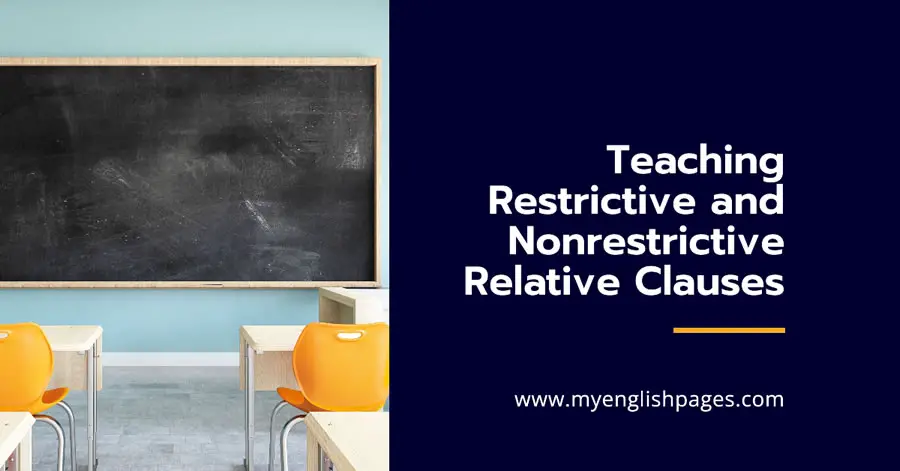This post explores how to teach restrictive and nonrestrictive clauses. For an in-depth guide, check our comprehensive guide on relative clauses.
Table of Contents
Introduction
Understanding the difference between restrictive and non-restrictive relative clauses is crucial for mastering English grammar. Restrictive clauses provide essential information that defines or identifies the subject, while non-restrictive clauses offer additional details and are set off by commas.
This lesson plan is designed to help students practice distinguishing between these two types of clauses through interactive activities and examples.
Lesson Plan Details
Teaching Restrictive and Nonrestrictive Clauses
- Level: Intermediate to Advanced
- Objectives:
- To distinguish between restrictive and non-restrictive relative clauses.
- To practice identifying and using relative clauses correctly in sentences.
- To enhance understanding of how relative clauses function in providing essential or additional information.
- Materials: Whiteboard, markers, handouts with example sentences and charts, and a text about Michael Jackson.
- Duration: 60 minutes
Teaching Restrictive and Nonrestrictive Clauses
Teaching restrictive and nonrestrictive clauses may be challenging. However, this step-by-step lesson plan will make the process easy:
1. Contextualizing Restrictive and Nonrestrictive Clauses
Students read this short text and answer the true or False questions below:
Michael Jackson, who is often referred to as the King of Pop, was a legendary musician known for his groundbreaking music and performances. His album which was released in 1982 is one of the best-selling albums of all time. Michael Jackson, whose influence on music and dance is unparalleled, passed away in 2009, but his legacy continues to inspire artists around the world.
True or False Questions
- Michael Jackson’s album released in 1982 is considered one of the best-selling albums of all time. (True)
- The text says Michael Jackson was known for his achievements in Rock music. (False)
- Michael Jackson, who passed away in 2009, is still an inspiration to artists today. (True)
Students then underline examples of relative clauses:
- Michael Jackson, who is often referred to as the King of Pop, was a legendary musician known for his groundbreaking music and performances.
- His album which was released in 1982 is one of the best-selling albums of all time.
Students work in pairs or small groups to notice the difference between the two relative clauses.
2. Introduction to Relative Clauses
To make the difference more obvious you may add more examples.
- Write the following two sentences on the board:
- Michael Jackson, who was a famous singer, died of an overdose.
- The man who sent the anonymous letter is the real murderer.
- Ask students to:
- Underline the relative clauses.
- Underline the relative pronouns.
- Decide which relative clause is essential (restrictive) and which is non-essential (non-restrictive).
- Identify which clause is placed between commas.
3. Discussion
- Discuss the definitions of restrictive and non-restrictive relative clauses:
- Restrictive Relative Clauses: Provide essential information that defines a term or expression. They are not set off by commas.
- Non-Restrictive Relative Clauses: Offer additional information without defining the term. They are set off by commas.
4. Practice
- Study the following examples and complete the chart:
- These are the regions which have been affected by the flood.
- My grandmother, who is dead now, used to teach English in Egypt.
- The museum, which we have never visited, is organizing a retrospective exhibition which will include more than 100 works of art by the Impressionist Salvador Dali.
- They’re the people who want to sell the shop.
- Paris, where John lives, is the destination for my next vacation.
- The actress is now playing a woman whose husband was killed in the Second World War.
The Chart
| Relative Pronoun | Clause | Restrictive or Non-Restrictive |
|---|---|---|
| which | … | … |
| who | … | … |
| where | … | … |
| whose | … | … |
5. Follow-Up

Complete the following sentences using appropriate relative clauses:
- Barack Obama…
- The girl…
- My mother…
- The boy….
- The house….
- My elder sister…
Possible answers:
- Barack Obama, who is known for his speeches, was the 44th President of the United States.
- The girl who won the competition is my cousin.
- My mother, who loves gardening, grows her own vegetables.
- The boy whose bike was stolen is very upset.
- The house where I grew up has been renovated.
- My elder sister, who lives in New York, is coming to visit.
Conclusion
This lesson plan provides a structured approach to understanding and practicing restrictive and non-restrictive relative clauses. Through identifying examples, completing charts, and using relative clauses in context, students will enhance their grasp of this essential grammatical concept.
The activities encourage critical thinking and practical application, helping students to use relative clauses effectively in both written and spoken English.
More on restrictiveness in English grammar


